Learning to print the letters needs to be approached in a stepwise manner by starting with the basic units (letter strokes) that make up the letters and moving on to combining these units to form letters.
Why use a stroke based approach to teaching letters in kindergarten?
All drawing and handwriting of letters and numbers is produced by a series of strokes that form curved and straight lines in different directions, which are linked together to form patterns, shapes, letters and numbers.
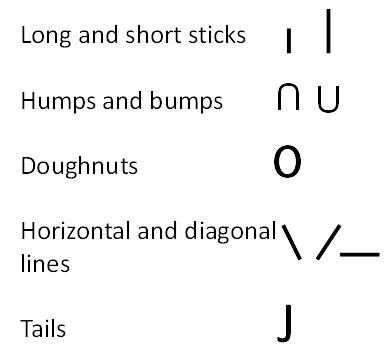
Max's pirate ship includes all the strokes needed for handwriting letters, and his ability to evenly size and space the portholes and stick figures is quite remarkable.

A stroke based approach to learning to print letters is a matter of building a library of motor plans for the different combinations of strokes that are used for producing letters and numbers, so that a letter, or series of letters to be preplanned and produced without need for visual guidance. An important aspect of this learning is the increasingly strong and automatic association between the sound of the letter (phoneme), the shape of the letter (grapheme) and the motor plan for the letter.
Learning the motor plan for the letter occurs when the child is first given the opportunity to practice forming letters using smoothly executed movements which are not constrained by accuracy demands. Once the motor plan is well established and the child is able to link the strokes to form letters in a smooth manner without the need for visual guidance, attention can be given to writing accurately between lines.
Approaches to teaching handwriting that use tracing letters and writing letters accurately between lines shifts the child's strategy for writing letters away from a fluent pre-planned actions using to using visually guided movements to write letters. Reliance on visual guidance inhibits learning the motor plan for the letter.
How children acquire the ability to produce accurate pre-planned strokes
At the beginning of the kindergarten year young children with good motor coordination and attention abilities will have acquired the ability to draw straight and curved lines (called strokes) to form a variety of shapes and patterns.
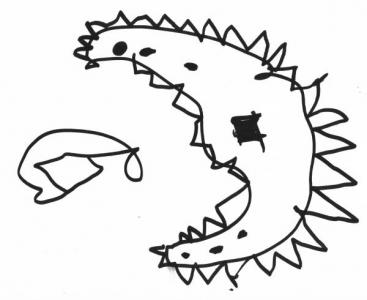

Over the course of the kindergarten (Gr R) year, children who are given the opportunity to do a lot of drawing will improve their ability to draw lines (strokes) that are smooth, and to link these strokes together to form shapes and patters that are well spaced and sized.

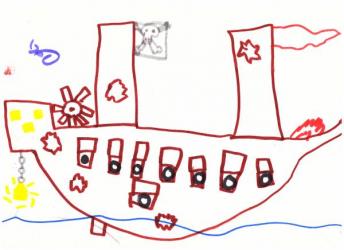
Learning to print letters and numbers is an easy task for children who have acquired the coordination and graphic abilities to produce and link the strokes that make up the letters. All they need to do is learn the motor plan for each letter and very quickly are able to make the brain connections that link the sound of the letter (phoneme), the visual image of the letter (grapheme) and the motor plan that produces the letter.

What about children who have not acquired the basic graphic abilities?
Perhaps the most effective way to help these children is to take a step back and provide them with the opportunity to improve their basic graphic abilities using guided practice principles.
The Kindergarten Drawing Activities: A Guide for Parents and Teachers book is a good place to start.

Why a stroke based approach with guided practice is important in DCD and ASD
Children with DCD and autism have difficulties learning new motor plans (sometimes referred to as internal models) because of differences in the way the brain is wired. Most approaches to teaching handwriting rely on tracing over printed letters which encourages the child to use continual visual monitoring of their movements. This practice inhibits the formation of motor plans as the child does not have to recall the motor plan to write the letter, instead the letter is formed by a series of short strokes guided by visual feedback.
Children with autism have particular difficulties using online visual feedback, but make good use of proprioceptive feedback from the muscles and joints. A stroke based approach which emphasizes the development of motor plans for letter formation, builds on the child's sensory strengths and implicit learning abilities. Once the letter is completed children with autism are able to evaluate the shape and size ot the letter and use their superior ability for seeing detail to provide feedback that can be used to adapt the motor plan.
A stroke based approach, along with guided practice provides children with DCD and autism the best environment for learning and improving their handwriting.
The HWG Approach to Teaching Letters
Start with teaching the basic strokes
Introducing young children who are just starting to print letters to the basic strokes used to form letters and showing them how these can be joined to form letters has several advantages:
- Firstly it ensures that the child learns to print letters using the correct sequence of strokes right from the start.
- The other advantage is that the child starts torecognise the strokes that make up any new letters that they encounter. This is the start of developing the connection between printed letters and the motor plan for the letter.
- Once a child has learned the to write and recognise the letter strokes, they will quickly recognise them in any new letter they encounter and are often able to print the letter with minimal specific training for the writing the particular letter.
Letter strokes are the basic units for printing letters
Each letter is written by combining two or more strokes in succession. Well learned, fluently written letters are produced by a rapid pre-planned movement that does not require visual monitoring. Visual feedback following the completion of printing the letter is used to asses the quality of the letter.
Each letter stroke has a specific direction, length and curvature relative to the other strokes in a letter.
The most common strokes are sticks, humps and doughnuts

Why "doughnut" letters?
The term doughnut is used for the closed rounded stroke used to form letters such as an a or d. Because it is an unusual name it differentiates the stroke from a circle.
It also starts with the letter d. This allows the child to remember that a d starts with a doughnut in contrast to a b which starts with a bat (stick) followed by a ball (closed hump).
Letters are formed by writing the letter strokes in succession
Doughnut letters are formed by a doughnut followed by a stick or tail. A doughnut is always written in an anticlockwise direction.
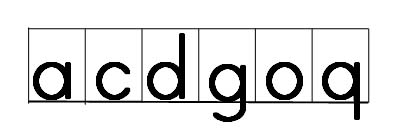
Stick letters start with a stick followed by an open or closed hump.
Sticks are always written from top to bottom. A hump is always written in an anticlockwise direction.
A k is the exception to the stick followed by a hump rule.

Diagonal letters are formed by diagonal lines.
v,ww.x,z
Exceptions include
e,f,j,s,t. and u
Letters occupy a letter space
It is useful to introduce young children to the concept of a letter space. Each letter occupies a space - called the letter space.
The first stroke of a letter starts in a particular position in the letter space. Writing a letter involves:
- recalling the motor plan (the sequence of strokes),
- selecting the starting position for the letter within the letter space e
- writing the strokes in the correct sequence.
Stick letters all start towards the top or halfway down on the left hand side of the letter space.
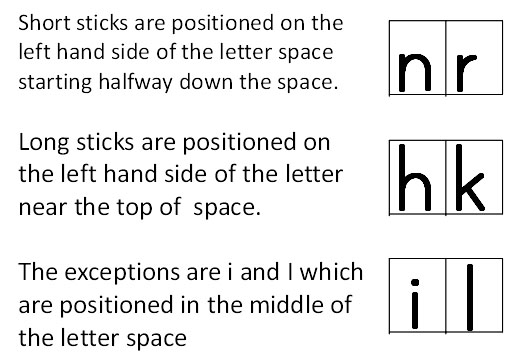
Doughnut letters all start on the right side of the letter space, just below the halfway point.

Teaching letters as strokes avoids letter reversals
Teaching letters by emphasizing the basic strokes with an emphasis on the starting position for the letter within the letter space, avoids the issue of letter reversal, particularly writing a b and a d.
A b is a stick letter - a stick followed by a closed hump. The mnemonic is b = bat and ball.

A d is a doughnut letter.The mnemonic is d=doughnut.

Handwriting Gym Online Manual
Purchase a subscription now. Just $20 for a 12 months subscription
Your Handwriting Gym subscription includes
New Kindergarten Drawing Activities
A 46 page PDF download with activities for training the motor coordination and graphic abilities needed for learning to print letters and numbers.
Developing Graphic Skills: Assessment Manual - a 45 page PDF download
A guide to assessing a child's basic drawing abilities, which are an essential prerequisite for handwriting
Training for sitting posture for handwriting. A 12 page PDF download
Exercises for improving sitting posture for working at a table.
Teaching handwriting using a stroke based approach - an online manual
- Why tracing is a very bad idea
- Using a letter outline to guide the pencil when forming letters inhibits learning the motor plan for a letter.
- How to use sound feedback to improve fluency
- Listening to the sound that the pencil makes on the paper cues fluency.
- Writing tools, materials, writing and templates
- All the equipment you will need for your handwriting sessions
- How to use grids, blocks and letter spaces
- Each letter occupies a space called the letter space
- How to teach humps and bumps
- Writing long and short sticks
- Writing donut letters
- How to avoid and correct letter reversals: b's and d's
Source: https://skillsforaction.com/handwriting/stroke-based-approach
Posted by: samsamduprate0267131.blogspot.com